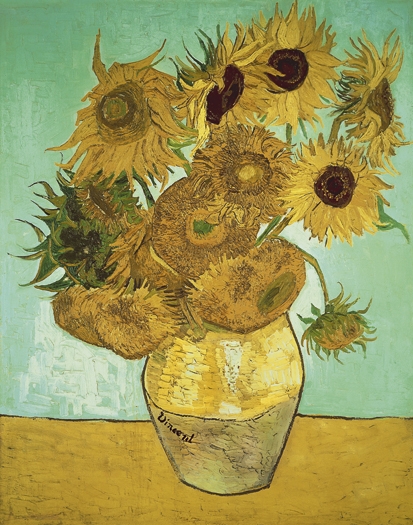‘How could a man who has loved light and flowers so much and has rendered them so well, how could he have managed to be so unhappy?’ This was Claude Monet’s comment on seeing Van Gogh’s ‘Three Sunflowers’ (1888). There he put his finger on one of the enigmas of the Dutch painter’s tragic life.
The journalist and scholar Martin Bailey has written an admirable new book which tells the story of Van Gogh’s life and posthumous rise to fame through the pictures of sunflowers, Helianthus annuus, which the painter produced at intervals through his brief career.
Following Monet’s thought, one might go on to wonder how someone as isolated and unpopular as Van Gogh (1853-1890), could have gone on to become so extravagantly celebrated post mortem. Collectively, his ‘Sunflowers’ have a good claim to be the world’s best-loved pictures. Certainly they vie with any by Velázquez, Leonardo, Michelangelo or Rembrandt — the artists Vincent himself so greatly revered — in popular esteem.
Bailey calculates that some five million visitors annually gaze at various versions of the ‘Sunflowers’ in the five public galleries in which they hang in three continents. The floor in front of ‘Fifteen Sunflowers’, the greatest of the sequence, is the most scuffed in the National Gallery, and the postcard of it the museum’s bestselling image.
Yet on its first public appearance this very painting nearly provoked violence. As Bailey records, the opening banquet in Brussels on 18 January 1890 of an exhibition organised by the ‘Les Vingt’ — an association of 20 avant-garde artists — almost led to multiple fatalities. One of the participating painters, a Belgian named Henry de Groux, was so ‘exasperated’ by the sight of the National Gallery ‘Sunflowers’ that he insulted Van Gogh — who was not present, being in the hospital of St Rémy in the south of France, with a few months to live. De Groux declared Vincent ‘an ignoramus and a charlatan’. Immediately, Toulouse-Lautrec, one of Van Gogh’s few friends, challenged him to a duel. Seconds were appointed. Paul Signac, another supporter of Vincent’s, declared that if the very short Toulouse-Lautrec were injured or killed in combat with the slightly taller Belgian, he would take up the matter himself. Only with difficulty was order restored.
The fundamental reason for Vincent’s lack of renown and sales during his lifetime was the astonishing speed of his development. In January 1890, he was less than a decade away from a standing start as a largely self-taught artist. Furthermore, he had come to true greatness as a painter during his time in Arles. Indeed it would only be a small exaggeration to say he attained supreme, power between 21 and 26 August 1888. During that six-day period, he conceived and completed four sunflower paintings: a rate approaching a masterpiece a day.
The speed and development were explosive: from the near naturalism of the first of those pictures (the one Monet was looking at), through the audacious yellow on royal blue ‘Six Sunflowers’, to the yellow-orange on turquoise ‘Fourteen Sunflowers’ now in Munich and the culminating National Gallery picture, with which Vincent’s art came to full blossom.
Van Gogh was living dangerously fast. Something had to give. Soon, it did. At the end of the year came the ear-cutting episode, followed by spells of mental collapse and hospitalisation. Within 18 months he was dead.
The second half of Bailey’s book charts in fascinating detail the fates of the paintings, including three later, slightly less satisfactory repetitions of the August 1888 pictures. The most dramatic story is of ‘Six Sun-flowers’, destroyed in a bombing raid on Japan in 1945. Bailey has unearthed an obscure 92-year-old colour photograph of this which almost has the effect of restoring a brand-new Van Gogh masterpiece to us.
An indefatigable researcher, Bailey has made important discoveries about the artist in the past, and here presents new ones. Most notable is a hitherto unknown newspaper report of the ear mutilation, recording the strange words Vincent seems to have uttered as he handed over the bloodstained package of lobe and cartilage to a brothel in Arles: ‘Take it, it will be useful.’
Bailey’s book is one that everyone interested in Van Gogh will want to own. It concludes with a partial solution to the conundrum Monet articulated: how could such a tormented man produced pictures seeming so joyous. In a letter to his youngest sister, Vincent wrote that his Arles sunflowers were ‘almost a cry of anguish’, while also symbolising gratitude. In other words, the greater the turmoil of his inner life, the more intensely he clung to the beauty of the world.






Comments